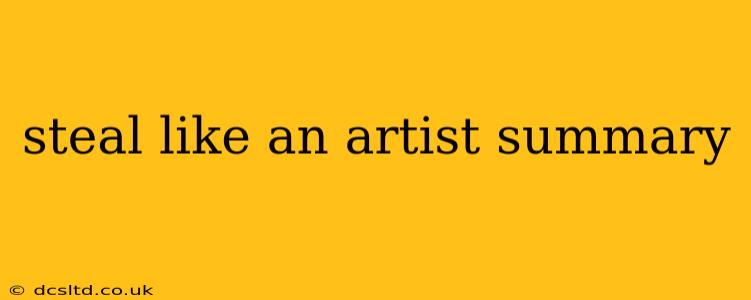Steal Like an Artist: A Summary of Austin Kleon's Creative Manifesto
Austin Kleon's Steal Like an Artist isn't a guide to intellectual property theft; it's a vibrant manifesto encouraging creative individuals to embrace influence and build upon the work of others. This deceptively simple book offers a refreshing perspective on creativity, arguing that originality isn't about inventing everything from scratch, but rather about intelligently combining and transforming existing ideas.
The core message revolves around the idea of "copying" as a crucial stage in the creative process. Kleon reframes the concept of plagiarism, proposing that true artistry lies not in avoiding influence, but in acknowledging and transforming it. He argues that artists throughout history have built upon the work of those who came before them, constantly remixing and reimagining existing forms.
Here's a breakdown of the key takeaways:
1. Don't wait until you're good to start.
Kleon emphasizes the importance of starting now, even if you feel unprepared or lack confidence. The act of creating, however imperfect, is far more valuable than waiting for the perfect moment or feeling completely ready. He encourages readers to embrace the messy, iterative nature of the creative process.
2. Write the book you want to read.
This applies to any creative endeavor. Create the work you wish existed in the world. If you're passionate about a topic, chances are others share that passion, and your work will resonate with them.
3. Share your work.
Putting your creations out into the world is essential for feedback and growth. Kleon emphasizes the power of the internet and social media for connecting with others and building a community around your work. Don't be afraid to show your process; embrace imperfection.
4. Steal like an artist (but ethically).
This is where the title comes into full fruition. Kleon outlines the ethical dimension of his argument: acknowledge your influences. He advocates for remixing, not plagiarizing. Build upon existing ideas, but always give credit where it's due. This involves understanding copyright law and giving proper attribution to your sources.
5. Be an interesting person.
Kleon emphasizes the importance of living a rich and engaging life. Your experiences, passions, and interests will inevitably inform your creative work and make it more unique and compelling.
6. Show your hand.
Transparency in your creative process can be beneficial. Show your influences, your sketches, your failures. This not only builds authenticity, but also humanizes your work and makes you more relatable to your audience.
7. Be cool.
Kleon's definition of "cool" isn't about superficial trends; it's about genuine originality, authenticity, and a willingness to experiment. It's about being confident in your own unique voice and perspective.
Frequently Asked Questions (often implied within the book):
Isn't this encouraging plagiarism?
No. Kleon differentiates between plagiarism and inspiration. Plagiarism is presenting someone else's work as your own. Inspiration involves taking elements from others’ work and transforming them into something new and original. Proper attribution and understanding copyright are vital.
How do I know what to "steal"?
Pay attention to what excites you, what resonates with you. Read widely, listen to diverse perspectives, explore different art forms. The "stealing" is a process of finding connections, building on existing ideas, and adding your own unique voice.
Isn't true originality about creating something entirely new?
Kleon challenges this notion, arguing that even the most seemingly original works draw inspiration from somewhere. True originality comes from intelligently combining existing elements in a novel way, not from creating something entirely out of nothing.
In essence, Steal Like an Artist is a call for creative confidence and a reimagining of the relationship between inspiration, imitation, and originality. It’s a reminder that creativity is a process of continuous learning, adaptation, and collaboration.
